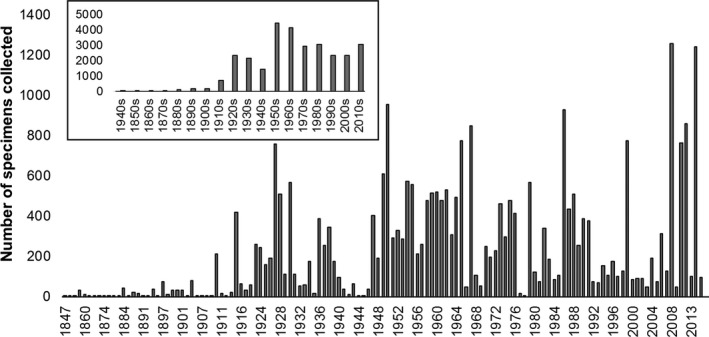Herbarium specimens are more and more utilized in phenological research. Nevertheless, pure historical past collections can have biases that affect the evaluation of phenological occasions. Arctic environments, the place remoteness and chilly local weather govern assortment logistics, might give rise to distinctive or pronounced biases.
We assessed the presence of biases in time, area, phenological occasions, collectors, taxonomy, and plant traits throughout Nunavut utilizing herbarium specimens accessioned on the Nationwide Herbarium of Canada (CAN).
We discovered durations of excessive and low assortment that corresponded to societal and institutional occasions; better assortment density near frequent factors of air and sea entry; and preferences to gather crops on the flowering part and in peak flower, and to gather specific taxa, flower colors, development kinds, and plant heights.
One-quarter of collectors contributed 90% of the gathering.Collections influenced by temporal and spatial biases have the potential to misrepresent phenology throughout area and time, whereas these formed by the pursuits of collectors or the tendency to favour specific phenological levels, taxa, and plant traits may give rise to imbalanced phenological comparisons.
Underlying assortment patterns might differ amongst areas and establishments. To information phenological analyses, we suggest routine evaluation of any herbarium knowledge set previous to its use.

Managing Analysis Animal Specimens and Laboratory Security.
The procedures essential to carry out testing in a veterinary diagnostic laboratory have inherent related dangers to personnel in regard to publicity to infectious brokers. In analysis establishments animals could be experimentally contaminated, purchase naturally occurring infections and may also be uncovered to different hazards similar to poisonous chemical compounds or radiologic entities.
A vital element of using animals in a analysis atmosphere is the collaboration between the accountable researcher and the veterinary diagnostic laboratory with the institutional well being and security professionals to make sure that the correct engineering controls, private protecting tools, laboratory procedures and coaching are in place for personnel working with the animals or their specimens.
In contrast to the everyday researcher, the veterinary diagnostic laboratory typically must be geared up to soundly course of and work with a variety of potential hazards the place the communication of pertinent data from the researcher to the diagnostic laboratory concerning the identification of the potential hazard is paramount.
Diagnostic laboratory design, security tools, private protecting tools, laboratory procedures, occupational well being program and personnel coaching have to be ample to handle hazards primarily based on a danger evaluation carried out along side security professionals. This text will summarize security concerns with the assorted areas of concern within the operation of a diagnostic laboratory for analysis animal specimens.
